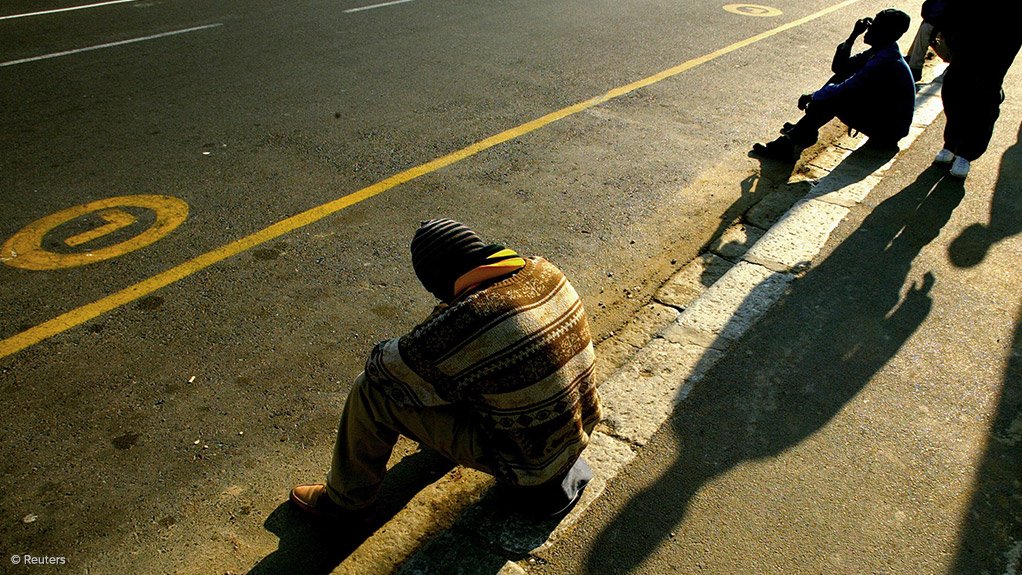The official South African unemployment rate has decreased by 0.8 of a percentage point to 34.5% in the first quarter of this year, compared with the unemployment rate of 35.3% in the fourth quarter of 2021.
Statistics South Africa (Stats SA) statistician-general Risenga Maluleke on May 31 shared the results of the latest Quarterly Labour Force Survey for the quarter ended March 31, highlighting that 370 000 jobs were gained between the fourth quarter of last year and the first quarter of this year.
The biggest job gains, of 281 000, were recorded in community and social services, followed by manufacturing gaining 263 000 jobs and trade employing 98 000 more people. The mining sector also managed to gain 36 000 jobs in the quarter under review.
There were, however, job losses recorded from private households totaling 186 000 and finance totaling 72 000, while the construction and agriculture sectors also shed jobs to the tune of 60 000 and 23 000, respectively.
Meanwhile, the unemployment rate according to the expanded definition, which includes discouraged work-seekers, also decreased by 0.7 of a percentage point to 45.5% in the first quarter.
The total number of people employed in South Africa was 14.9-million, against 7.9-million unemployed people at the end of the first quarter.
The number of unemployed people decreased by 60 000 quarter-on-quarter.
The number of discouraged work-seekers decreased by 54 000 and the number of people who were not economically active for reasons other than discouragement decreased by 112 000, resulting in a net decrease of 166 000 non-economically active people.
Maluleke reiterated that young people remain vulnerable in the labour market, despite a slight decrease in the number of unemployed youth in the first quarter of the year.
The total number of unemployed youth – aged between 15 and 34 years – declined by 5 000 to 4.7-million people.
He says there was a noticeable increase in the number of youth in employment, up by 5%, or 244 000, during the quarter. The youth unemployment rate, therefore, improved to 47.8% – a 1.2 percentage point increase compared with the fourth quarter of last year.
South Africa’s unemployment rate has been steadily rising over the last decade, alongside stagnant economic growth.
The formal sector in South Africa’s labour market accounts for 68.3% of total employment, keeping 10.2-million people employed, while the informal sector employs about 2.8-million people and accounts for 18.9% of total employment.
Private households account for 7.2% of total employment at 1.1-million, and agriculture accounts for 5.7% of total employment, keeping 800 000 people employed.
COMMENTARY
Altough the unemployment rate declined, a change in the Stats SA's survey method could have affected the outcome, says Nedbank. However, Stats SA assured media stakeholders during a briefing on May 31 that its feedback rate on its quarterly surveys has improved markedly, now that face-to-face interviews have resumed.
The bank adds that economic activity is broadly normalising from the Covid-19 shock as most major lockdown restrictions were removed, and companies' profitability are returning. Simultaneously, more people returned to the labour market as improving conditions increased job seekers' confidence in finding jobs.
Nedbank believes that employment in the domestic trade sector was mainly lifted by firmer activity in the hotel and tourism industries. "The annual numbers showed that the economy has not yet recovered enough to support a significant increase in employment creation," the bank states, adding that the outlook for the job market remains uncertain, owing to global stagflation.
North West University Business School economist Professor Raymond Parsons comments that it is not yet clear whether whether the latest improvement in the employment situation will be sustained in the months ahead, given the renewed negative global and domestic economic trends that have emerged in the second quarter of the year.
He mentions that gross domestic product growth is likely to be around 1.6% in 2022, and that South Africa needs to break out of its low growth trap by collectively expediting the urgent implementation of key economic reforms.
The Don Consultancy Group chief economist Chifi Mhango notes that although the South African government has drafted various policies to try create a conducive environment to investment and job creation, the persistent unemployment figures clearly shows it is yet to realise. Particularly, he says it is concerning how fewer key traditional sectors are contributing to GDP.
Mhango deems it vital to expand the industrial landscape through, for example, mineral beneficiation and an expanded market footprint through exports, as well as to address the electricity supply challenges and costs, and logistical costs and inefficiencies plaguing the country.
He compares South Africa's unemployment rate with that of the US at 3.6%, China at 6.1%, Europe at an average 6.8%, Brazil at 11%, Russia at 4.1%, India at 7.8%, Egypt at 7.2% and Kenya at 7.2%, saying that it is a national concern that needs urgent addressing through skills development for the youth, improved business environment and encouraged entrepreneurship.
EMAIL THIS ARTICLE SAVE THIS ARTICLE ARTICLE ENQUIRY
To subscribe email subscriptions@creamermedia.co.za or click here
To advertise email advertising@creamermedia.co.za or click here











